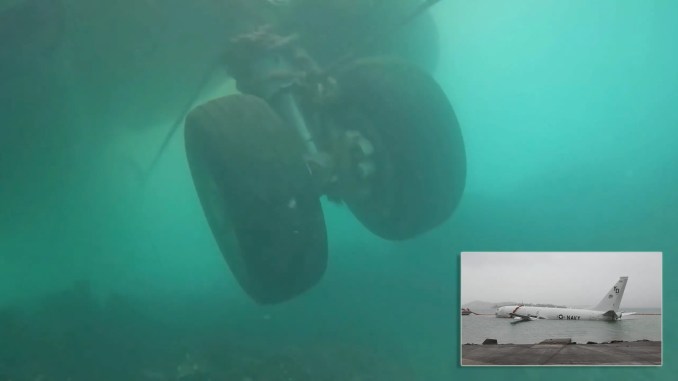
Thanks to the Navy Divers, we can have an underwater look at the P-8A in Kaneohe Bay, Hawaii.
The U.S. Navy has just released footage shot by divers assigned to Mobile Diving and Salvage Unit One (MDSU-1) who carried out an underwater survey of the P-8A Poseidon maritime patrol aircraft 169561 YD-561, belonging to the VP-4 “Skinny Dragons” based at Naval Air Station Whidbey Island, Washington, that ended in water after overshooting the runway during landing at Marine Corps Air Station Kaneohe Bay, Hawaii, on Nov. 20, 2023.
The video, collected to assess the conditions and impact of the incident to the marine environment, depicts the two points of contact the aircraft has with the coral and the remainder of the aircraft floating above. In fact, the aircraft is basically resting on coral, partly sitting on its nose and main landing gear while also maintaining most of its buoyancy.
According to the Third Fleet Public Affair, the Navy is developing a plan to remove the aircraft that prioritizes safety of people (salvage workers), safety of the environment and restoring combat capability of the aircraft. All nine crew members safely evacuated.
WATCH: US Navy divers conduct an underwater survey of a P-8A Poseidon in Kaneohe Bay in Hawaii on Nov. 28. The aircraft overshot runway at Marine Corps Base Kaneohe on Nov. 20, and all nine crewmembers safely evacuated. pic.twitter.com/zo9pYwppDD
— Ryan Chan 陳家翹 (@ryankakiuchan) November 30, 2023
In a press conference held on Nov. 27, Rear Admiral Kevin Lennox provided some updates on the recovery efforts and activities carried out on the aircraft. Here below are some of the most interesting parts of his speech.
“The Navy is a committed member of this community and a sincere advocate for the protection of our shared environment since the incident,” he said. “And through the weekend , this team has been singularly focused on developing a salvage plan for this aircraft that prioritizes the safety of personnel and the environment here in Kanehoe Bay. As a result of that, we’re mindful that we need to do better in communicating with our neighbors here about our progress. And that’s why we’re all here today.”
“We recognize and understand the significance of this bay, not just as a strategic location for the military, but as a critical ecosystem and a cherished part of the local community. We appreciate your understanding and patience as we navigate through the salvage process . Following the Navy and Marine Corps team’s immediate response at Marine Corps Base Hawaii, Navy Mobile Diving and Salvage Unit One based on Pearl Harbor began assessment and planning to execute the salvage plan. Navy divers arrived here within hours and worked quickly to stabilize the aircraft to minimize the risk of the spill. And the first step in that salvage plan was to remove as much fuel from the aircraft as possible to prepare for that process.”

“The Navy divers went back to Pearl Harbor to familiarize themselves with the P-8 and they practiced connecting and disconnecting the fuel lines to ensure that they weren’t doing it for the first time in the water. Yesterday, the team executed a slow and methodical refueling process. This was done to minimize the risk of environmental harm in the follow on salvage process. We estimate that the aircraft had just over 2,000 gallons of fuel on board and the team extracted all the fuel that they could get out of those tanks . This process was completed successfully without any fuel being released into the bay.”
“Our divers also conducted a hydrographic survey to better assess the coral and marine environment around the aircraft. The survey is helping the Navy plan a recovery operation that minimizes impact of the critical ecosystem here in Kanehoe Bay as we move to the next phase of salvage . The team of experts is working tirelessly to develop a course of action that prioritizes personnel safety , environmental safety and the restoration of mission capability.”
“Extensive technical analysis from both salvage and aircraft engineering specialists are integrated in developing this plan. The process has brought together experts experience and equipment from across the Department of Defense Interagency partners and private industry from as far away as Singapore and Louisiana. The safety and security of our community is paramount and our top priority. Our collective goal is to remove the aircraft as soon and as safely as possible.”
“An aviation mishap board is here on site and an administrative investigation led by a senior naval officer in the maritime patrol and reconnaissance force from outside the chain of command of the air crew in question has been designated and has begin to review investigative materials. The navy is committed to learning from this investigation regardless of the cause. These lessons will be valuable in preventing such incidents going forward, make us a better force and make us more combat capable.”
- SEO Powered Content & PR Distribution. Get Amplified Today.
- PlatoData.Network Vertical Generative Ai. Empower Yourself. Access Here.
- PlatoAiStream. Web3 Intelligence. Knowledge Amplified. Access Here.
- PlatoESG. Carbon, CleanTech, Energy, Environment, Solar, Waste Management. Access Here.
- PlatoHealth. Biotech and Clinical Trials Intelligence. Access Here.
- Source: https://theaviationist.com/2023/11/30/underwater-survey-of-p-8a/?utm_source=rss&utm_medium=rss&utm_campaign=underwater-survey-of-p-8a




